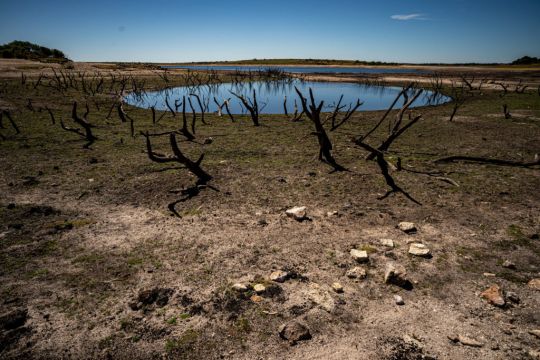Global temperatures dropped a minuscule amount after two days of record highs, making Tuesday only the world’s second-hottest day ever.
The European climate service Copernicus calculated that Tuesday’s global average temperature was 0.01C lower than Monday’s all-time high of 17.16C, which was .06C hotter than Sunday.
All three days were hotter than Earth’s previous hottest day last year.
Stanford University climate scientist Chris Field said: “The steady drumbeat of hottest-day-ever records and near-records is concerning for three main reasons.
“The first is that heat is a killer. The second is that the health impacts of heatwaves become much more serious when events persist. The third is that the hottest-day records this year are a surprise.”
He added that high temperatures usually occur during El Nino years — a natural warming of the equatorial Pacific that triggers weather extremes across the globe — but the last El Nino ended in April.
Mr Field said the high temperature “underscores the seriousness of the climate crisis”.
“This has been… probably the shortest-lived record ever,” Copernicus director Carlo Buontempo said on Wednesday after his agency calculated that Monday had beaten Sunday’s mark. He predicted that mark would also quickly fall, adding: “We are in uncharted territory.”
The Earth just experienced its 𝘄𝗮𝗿𝗺𝗲𝘀𝘁 𝗱𝗮𝘆 on record. 🌍🌡️
New @CopernicusECMWF data shows that last Sunday, the daily global average temperature reached a record high 17.09°C 📈
It marginally beats the previous record from 6 July 2023.
🔗https://t.co/dzjH8ZVpBA pic.twitter.com/6wHNPXVmW5— Copernicus EU (@CopernicusEU) July 24, 2024
Advertisement
Before July 3 2023, the hottest day measured by Copernicus was 16.8C on August 13 2016. In the last 13 months that mark has been beaten 59 times, according to Copernicus.
Humanity is now “operating in a world that is already much warmer than it was before”, Mr Buontempo said.
“Unfortunately people are going to die and those deaths are preventable,” said Kristie Ebi, a public health and climate professor at the University of Washington.
“Heat is called the silent killer for a reason. People often don’t know they’re in trouble with heat until it’s too late.”
In past heatwaves, deaths did not start piling up until day two, Ms Ebi said.
“At some point, the accumulated heat internally becomes too much, then your cells and your organs start to warm up.”
Last year, the US had its most recorded heat deaths in more than 80 years, according to an Associated Press analysis of Centres for Disease Control and Prevention data.
The death certificates of more than 2,300 people mentioned excessive heat, which killed 874 people in Arizona, 450 in Texas, 226 in Nevada, 84 in Florida and 83 in Louisiana.
Earlier this year, India witnessed prolonged heatwaves that resulted in the death of at least 100 people. Health experts say heat deaths are likely to be undercounted in India and potentially other countries.
The “big driver” of the current heat is greenhouse gas emissions, from the burning of coal, oil and natural gas, Mr Buontempo said. Those gases help trap heat, changing the energy balance between the heat coming in from the sun and that escaping Earth, meaning the planet retains more heat energy than before, he added.
Other factors include the warming of the Pacific by El Nino, the sun reaching its peak cycle of activity, an undersea volcano explosion, and air with fewer heat-reflecting particles because of marine fuel pollution regulations, experts said.
The last 13 months have all set heat records. The world’s oceans broke heat records for 15 months in a row and that water heat, along with an unusually warm Antarctica, are helping push temperatures to record levels, Mr Buontempo said.
“I wouldn’t be surprised to see Thursday, Friday and Saturday also set new warmest day records,” said climate scientist Andrew Weaver at the University of Victoria in Canada.







